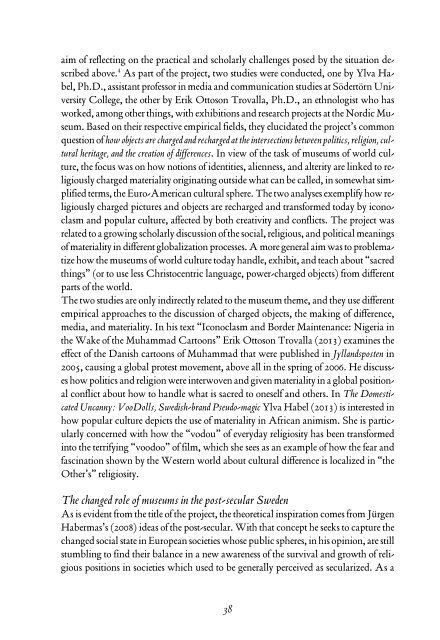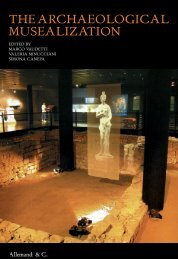RELIGION AND MUSEUMS - Allemandi
RELIGION AND MUSEUMS - Allemandi
RELIGION AND MUSEUMS - Allemandi
You also want an ePaper? Increase the reach of your titles
YUMPU automatically turns print PDFs into web optimized ePapers that Google loves.
aim of reflecting on the practical and scholarly challenges posed by the situation describedabove. 4 As part of the project, two studies were conducted, one by Ylva Habel,Ph.D., assistant professor in media and communication studies at Södertörn UniversityCollege, the other by Erik Ottoson Trovalla, Ph.D., an ethnologist who hasworked, among other things, with exhibitions and research projects at the Nordic Museum.Based on their respective empirical fields, they elucidated the project’s commonquestion of how objects are charged and recharged at the intersections between politics, religion, culturalheritage, and the creation of differences. In view of the task of museums of world culture,the focus was on how notions of identities, alienness, and alterity are linked to religiouslycharged materiality originating outside what can be called, in somewhat simplifiedterms, the Euro-American cultural sphere. The two analyses exemplify how religiouslycharged pictures and objects are recharged and transformed today by iconoclasmand popular culture, affected by both creativity and conflicts. The project wasrelated to a growing scholarly discussion of the social, religious, and political meaningsof materiality in different globalization processes. A more general aim was to problematizehow the museums of world culture today handle, exhibit, and teach about “sacredthings” (or to use less Christocentric language, power-charged objects) from differentparts of the world.The two studies are only indirectly related to the museum theme, and they use differentempirical approaches to the discussion of charged objects, the making of difference,media, and materiality. In his text “Iconoclasm and Border Maintenance: Nigeria inthe Wake of the Muhammad Cartoons” Erik Ottoson Trovalla (2013) examines theeffect of the Danish cartoons of Muhammad that were published in Jyllandsposten in2005, causing a global protest movement, above all in the spring of 2006. He discusseshow politics and religion were interwoven and given materiality in a global positionalconflict about how to handle what is sacred to oneself and others. In The DomesticatedUncanny: VooDolls, Swedish-brand Pseudo-magic Ylva Habel (2013) is interested inhow popular culture depicts the use of materiality in African animism. She is particularlyconcerned with how the “vodou” of everyday religiosity has been transformedinto the terrifying “voodoo” of film, which she sees as an example of how the fear andfascination shown by the Western world about cultural difference is localized in “theOther’s” religiosity.The changed role of museums in the post-secular SwedenAs is evident from the title of the project, the theoretical inspiration comes from JürgenHabermas’s (2008) ideas of the post-secular. With that concept he seeks to capture thechanged social state in European societies whose public spheres, in his opinion, are stillstumbling to find their balance in a new awareness of the survival and growth of religiouspositions in societies which used to be generally perceived as secularized. As a38







